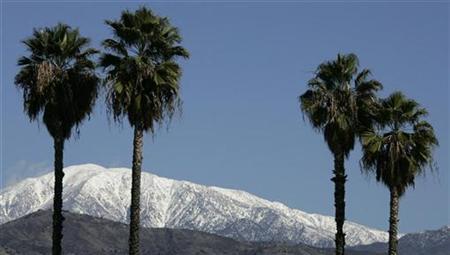Palms Grew In Ice-Free Arctic 50 Million Years Ago: study
Country: NORWAY
Author: By Alister Doyle, Environment Correspondent

Snow is shown on the San Bernardino mountians
framed by four palm trees in Covina, California December 26, 2008.
Photo: Fred Prouser
OSLO - Palms flourished in the Arctic during a brief sweltering period about 50 million years ago, according to a study on Sunday that hints at big gaps in scientific understanding of modern climate change.
The Arctic "would have looked very similar to the vegetation we now see in Florida," said Appy Sluijs of Utrecht University in the Netherlands who led an international study. Evidence of palms has never been found so far north before.
The scientists, sampling sediments on a ridge on the seabed that was about 500 km (300 miles) from the North Pole 53.5 million years ago, found pollens of ancient palms as well as of conifers, oaks, pecans and other trees.
"The presence of palm pollen implies that coldest month mean temperatures over the Arctic land masses were no less than 8 Celsius" (46.40F), the scientists, based in the Netherlands and Germany, wrote in the journal Nature Geoscience.
That contradicts computer model simulations -- also used to predict future temperatures -- that suggest winter temperatures were below freezing even in the unexplained hothouse period that lasted between 50,000 and 200,000 years in the Eocene epoch.
Palms are quickly killed by frost.
Sluijs said that it was also striking that palms, which do not lose their leaves in winter, grew in an area where the sun does not shine for about five months. Experiments with modern palms indicate that they can survive prolonged darkness.
SURPRISES
The scientists said that presence of palms -- it was not clear if they were trees or plants -- hinted that the modern climate system could yield big surprises.
Temperatures are now rising because of man-made greenhouse gases, mainly from burning fossil fuels, according to the U.N. Climate Panel. Arctic ice shrank in 2007 to its smallest size since satellite measurements began in the 1970s.
One possibility for the ancient spike in temperatures was an abrupt rise in carbon dioxide levels, to far beyond concentrations now. That might have been caused by volcanic eruptions, or a melt of frozen methane trapped in the seabed.
"We cannot explain this with the current knowledge of the climate system," Sluijs said. One possibility was that new types of clouds formed in the Arctic as it warmed, acting as a blanket that trapped ever more heat and accelerated warming.
"If the ocean was very warm it's possible that these clouds form at a higher latitude than now," he said. Such effects caused by new cloud formation could be an unexpected tripwire in accelerating modern climate change.
More than 190 nations are due to meet in Copenhagen from December 7-18 to agree a new U.N. climate treaty to succeed the U.N.'s Kyoto Protocol.
© Thomson Reuters 2009 All rights reserved
